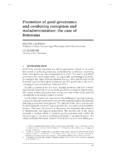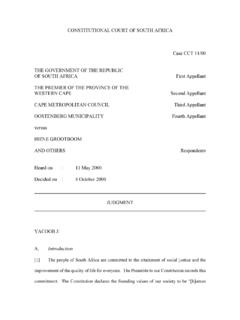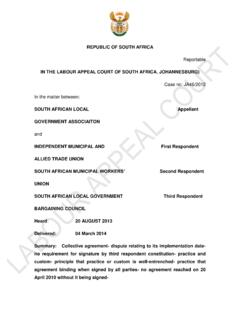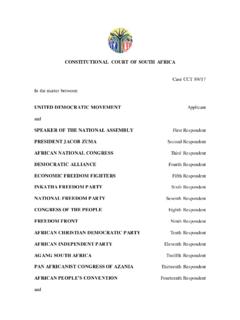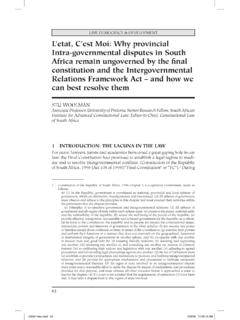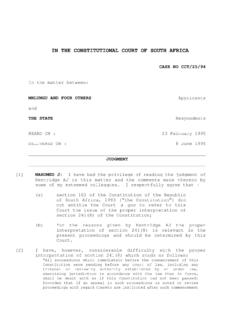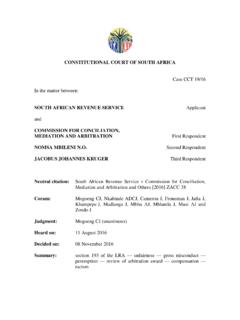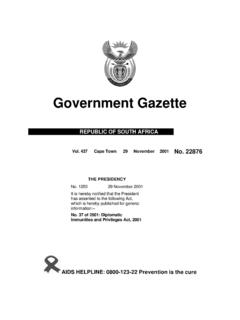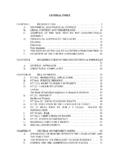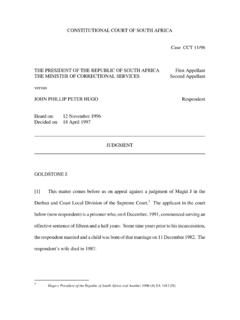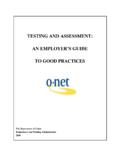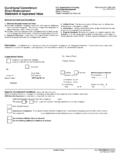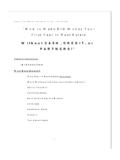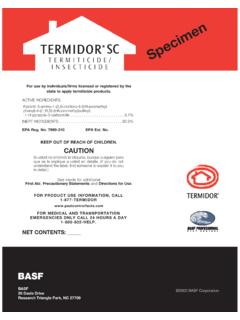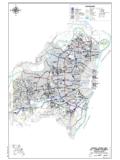Transcription of IN T H E H IG H C O U R T O F S O U T H A F R IC ... …
1 IN THE HIGH COURT OF SOUTH AFRICA (ORANGE FREE STATE PROVINCIAL DIVISION) Application No. : 4281/07 In the application between:- REAL PEOPLE HOUSING (PTY) LTD Applicant and OLIHILE SHADRACK MOTSHABI Respondent HEARD ON: 1 NOVEMBER 2007 _____ JUDGMENT BY: KRUGER J _____ DELIVERED ON: 15 NOVEMBER 2007 _____ [1] Applicant wishes to be substituted for the Standard Bank of South Africa Ltd ( Standard Bank ) in case no. 494/1993, where respondent was the defendant. Standard Bank obtained default judgment against respondent on 4 March 1993 for the payment of R44 790,59 plus interest of 16,75% per annum compounded monthly, from 1 January 1993 and an order declaring the bonded property executable, and costs on the 2attorney and client scale.
2 Standard Bank is not a party to the present application and the application was not served on it [2] Substitution of parties by the court after judgment is possible. In EX PARTE ESTATE LE ROUX 1919 CPD 164 the court granted substitution of a ceded judgment where the judgment debtor had not been heard of for 15 years. In EX PARTE SCOTT 1910 WLD 256 the court granted an order substituting the applicant for the judgment debtor. Curlewis J expressed the opinion that the better procedure would have been to have given notice to the judgment debtor.
3 The procedure of approaching the court to assist in the enforcement of a ceded judgment has been adopted in our practice. The cessionary approaches the court asking for an order substituting the cessionary for the cedent (KADER v FRANK AND WARSHAW AND ANOTHER 1926 AD 344 at 347; COHEN v MALLINCK 1957 (1) SA 615 (C) at 619 A D). It is doubtful whether rule 15 applies to such application (Harms, Civil Procedure in the Supreme Court, par. ). Rule 15 is confined to the cases where substitution becomes necessary by reason of death, 3marriage or other change of status (Herbstein and Van Winsen, The Civil Practice of the Supreme Court of South Africa, 4th Edition (1997) 757 footnote 23).
4 Under Rule 15(2) an application to substitute a party is brought by any party to the proceedings by notice to such further person to every other party and to the registrar , where a substitution takes place after judgment. The judgment creditor has acquired rights, which can then be ceded, calling for a substitution. Such cessionary could issue summons on the ceded claim the cession is or embodies its cause of action. In such summons the judgment creditor is completely out of the picture. Theoretically the judgment creditor is also out of the picture in an application for substitution.
5 It will have to depend on the circumstances of each case whether it will be necessary to join the judgment creditor, or at least serve the application on the judgment creditor. Where there has been a delay in excess of three years, service on the judgment creditor seems a sound practice, not involving excessive costs. 4[3] The right to housing is protected in Constitution 26(1). Any measure permitting a person to be deprived of existing access to adequate housing limits Constitution 26(1) (JAFTHA v SCHOEMAN AND OTHERS; VAN ROOYEN v STOLTZ AND OTHERS 2005 (2) SA 140 (CC) par.)
6 [34]). Whether the measure is justified requires a balancing of various interests. Therefore section 66(1)(a) of the Magistrates Courts Act 32 of 1944 must be read subject to the requirement that a writ of execution against immovable property can be issued only upon an order of court after consideration of all relevant circumstances (STANDARD BANK OF SA LTD v SAUNDERSON AND OTHERS 2006 (2) SA 264 (SCA) par. [12]). In this case there was a court order on 4 March 1993. The circumstances around the occupation may, however, have changed since then 14 years have elapsed.
7 The judgment debtor may have entered into an agreement with the original judgment creditor, Standard Bank, to pay off the debt. Although that order was made before the Constitution came into being, the possible violation of the judgment debtor s rights (respondent herein) will take place after the Constitution came 5into force, and he will be entitled to rely on the protection afforded by the Constitution (see Currie and de Waal, The Bill of Rights Handbook, 5th Ed (2005) 57 60; KEY v ATTORNEY-GENERAL 1996 (4) SA 187 (CC) par. [12]). Revival of the judgment [4] If no steps have been taken for three years to execute on the judgment, the executability of the judgment lapses.
8 At the revival application under Uniform Rule 66(1), the court has a discretion to grant or refuse it (COOPER v THE VAN RYN GOLD MINE ESTATES LTD AND MINING COMMISSIONER OF BOKSBURG 1908 TS 698 at 700 per Innes CJ, where the court refused to revive a 10 year old judgment because on the facts before it, revival would be futile). Rule 66 is discussed in detail in SEGAL AND ANOTHER v SEGAL 1992 (3) SA 136 (C); the approach to be followed is set out at 142G - 143A. Requirements for an application for substitution of a party after judgment 6[5] In my view, the requirements for an application for substitution of a plaintiff after judgment can be stated as follows: 1.
9 The application is brought in terms of the common law, not under Uniform Rule 15. 2. The right upon which the applicant relies must be established. If it is a cession, a copy thereof must be attached, linking the applicant to the judgment debtor. 3. The judgment debtor must be cited as respondent and the application must be served on the judgment debtor. If the delay since judgment has been more than three years, and declaring fixed property executable as part of the judgment, personal service will normally be required. 4. Depending on the length of the period from judgment, service should take place upon the original judgment creditor.
10 In general, this will be required where the judgment is older than three years. 5. If the delay since judgment exceeds three years, information must be furnished as to what transpired since the judgment was granted, in particular: (i) whether a writ of execution was taken out; 7(ii) whether any arrangements were made with the judgment debtor; (iii) in the case of a property which was declared executable, whether the judgment debtor is living in the house. 6. The applicant should state that it intends taking execution steps against the judgment debtor. 7. When the judgment is older than three years, the applicant should state that it intends applying for revival of the judgment under Rule 66.
